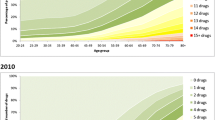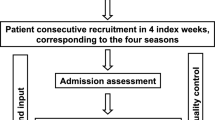Abstract
Objective: To analyse the occurrence of multiple drug use (polypharmacy, PP) in the population and to identify individuals particularly prone to PP.
Methods: Data were derived from the Odense Pharmacoepidemiological Database (OPED) and covered all subsidised prescriptions during 1994 presented by inhabitants in the county of Funen (n= 466 567). The number of individuals concurrently using two to four drugs (minor PP) and five or more drugs (major PP) was calculated on a random day in 1994. Drugs were classified according to the Anatomical Therapeutical Chemical (ATC) classification index. The main therapeutic class (second level of the ATC code) was used as an indicator for the type of health problem. A stepwise backwards logistic regression was used to identify predictors of major PP. Odds ratios were calculated for different drug classes, and the age and sex of all drug users.
Results: On a random day, 8.3% of the population were exposed to minor PP and 1.2% to major PP. The prevalence of PP increased with age, and from the age of 70 years, two thirds of all drug users were PP users. Drug use was 50% more prevalent among women than men, but over the age of 70, the sexes did not differ in the prevalence of major PP. Many different drug combinations were found, and among major PP users (n= 5443), two thirds had their own unique drug regimen, different from all other drug users. Cardiovascular drugs and analgesics were often involved in PP among the elderly, while asthma drugs, psychotropic drugs and anti-ulcer drugs were predominant among young individuals exposed to PP. The odds ratio (OR) for major PP was substantially increased for individuals treated for cardiovascular diseases (OR, 4.5), anaemia (OR, 4.1) and respiratory diseases (OR, 3.6).
Conclusions: PP is widespread in the population. Clinicians and organisers who are responsible for quality assurance programmes should intensify their surveillance of the groups most prone to PP (the elderly and those using analgesics or drugs for cardiovascular disease, anaemia, asthma and diabetes).
Similar content being viewed by others
Author information
Authors and Affiliations
Additional information
Received: 23 June 1997 / Accepted in revised form: 7 January 1998
Rights and permissions
About this article
Cite this article
Bjerrum, L., Søgaard, J., Hallas, J. et al. Polypharmacy: correlations with sex, age and drug regimen A prescription database study. E J Clin Pharmacol 54, 197–202 (1998). https://doi.org/10.1007/s002280050445
Issue Date:
DOI: https://doi.org/10.1007/s002280050445




